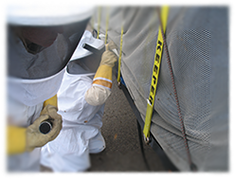Entering CA: Border Protection Stations (BPS)

Station Information Quick Links:
Inspections: What To Expect
Honeybee shipments entering California are subject to two inspections: A cursory inspection at the border station and a more detailed inspection at destination. These inspections are necessary because hitchhiking insect and weed pests - especially red imported fire ant (RIFA) - are often found associated with bee colonies.
Inspectors will check the exterior colonies and pallets; often this inspection requires the lifting of bee nets. While inspectors may assist with lifting and reattaching nets, it is ultimately the driver's responsibility to make the shipment ready for inspection.
If a pest is found in a shipment, scientists from CDFA's Plant Pest Diagnostics Laboratory must identify suspect pests found on bee shipments. Identifications are generally made electronically through photographs taken at the border station. Pest specimens are usually identified quickly when the shipment arrives during normal business hours (8 a.m. to 5 p.m. Monday through Friday). Although efforts are made to contact scientists after-hours, arriving at the border outside of lab business hours may cause delays if pests are found.
If a pest of concern is found on the colonies, or the shipment is contaminated with excessive soil or debris, the colonies and pallets must be cleaned (typically by pressure washing) prior to entering the state. At this time, contaminated shipments must return out of state for cleaning if pests of concern are found. Truck drivers are responsible for arranging the cleaning and any associated expenses."
If no pests of concern or excessive soil or debris contamination are found, the shipment is placed under a Quarantine Hold Notice and allowed to proceed to destination where it will be subject to inspection by the County Agricultural Department. Drivers should be prepared to give the exact physical location or address where the colonies will be placed (P.O. Boxes are not acceptable), the number of colonies, and the state of most recent origin (Township and range or GPS coordinates may be substituted for a physical address). This information is required so the appropriate county can be notified of the impending arrival of the shipment.
Shipments entering under Quarantine Hold Notice must proceed to the destination address on the form unless authorization is given by the County Agricultural Department to divert the shipment. Using the contact information on the hold notice, the driver or other responsible party must contact the County Agricultural Department for inspection. The shipment may not be offloaded until permission is given by the county inspector (unless the shipment is accompanied by a valid "ant free" certificate.) Most counties maintain business hours of 8 a.m. - 5 p.m., Monday through Friday, but hours may vary by county.


